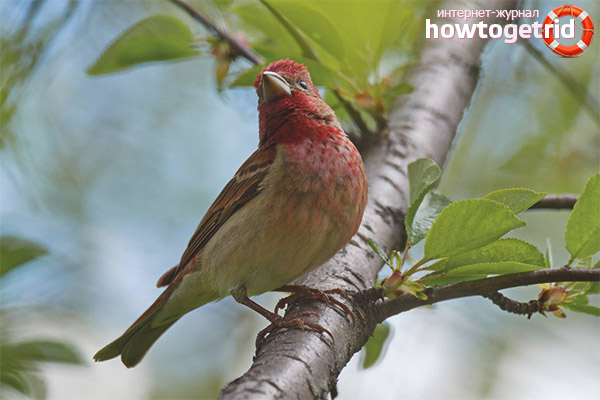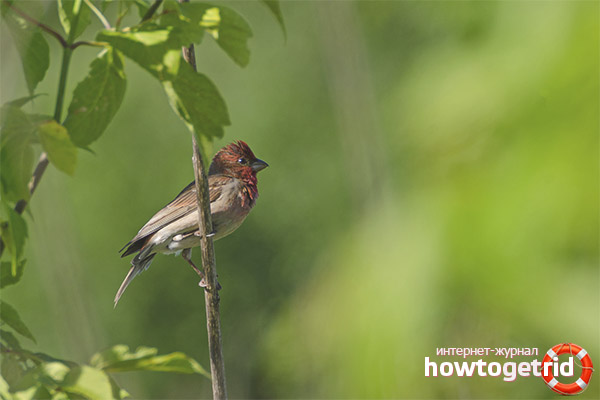The content of the article
A huge number of birds of various species live on earth. They differ in everything: size, behavior, manners, lifestyle. Many live in places that would seem completely unsuitable for existence - to take the same penguins. But we will not talk about them, but about a small brisk lentil.
Description
At the word lentils, the imagination immediately draws a cereal plant with flat grains, like beans. Few people know that this word refers to a migratory bird, very similar to a sparrow. Her name is also - a red sparrow.
In total there are 4 subspecies of this bird, each of them has slight differences in appearance and color, but in general terms they are similar. In terms of size, lentils fully repeat the parameters of an urban tweeter - length - up to 20 cm, weight - 80 grams, wingspan - 9 centimeters. Only two differences - a thick, slightly swollen yellow beak and a bright pink screaming color of males, from which you can immediately determine the type of bird. The plumage is almost completely red-pink, especially in the chest and goiter. Only the lower torso is pinkish-white and the undertail with the axilla is pristine white. On the lower back and lower neck, dark red feathers are decorated with a light border.
Females cannot boast of such a flashy bright color: their plumage is reddish-gray with a brown tint, the abdomen is slightly lighter than the back, the bottom of the body is cast with ocher, the wings are decorated with longitudinal light stripes.
Where dwells
Lentils prefer to be moist around and settle where there is excess moisture. For the most part, he selects flood meadows, where the bush grows abundantly, but can live on forest edges. Constantly seen in garden plots and cemeteries. In the highlands settles on forest edges, in estuaries and floodplains, in meadows.
Nesting and breeding
Lentils mainly prefer a solitary lifestyle, live in pairs only during nesting. Something like mating occurs: the males climb as high as possible on the tree, demonstrate their outfit, claw the tuft and fluffy feathers, sing loudly and for a long time, trying to surpass the opponent and show the uniqueness to the female. At times clashes between rivals arise, ending without harming the enemy. In the end, the female observing the performance from the lower tier or the ground makes her choice.
After mating, the female looks for a place for the nest, and both partners build a house for the next season. As a rule, the place is a tree or some kind of branchy bush. Moreover, the female can specifically choose a plant where other birds will not exactly nest - for example, in a thicket of nettles. The house is made very low from the ground, often - swampy and firebox. Dry building last year’s twigs, blades of grass, stalks of cereals and other plants growing nearby serve as building materials. The tray is done very carelessly (blades of grass and twigs stick out in all directions), it looks like a cup measuring 16-20 centimeters.The floor is laid out with its own and other people's down, feathers, pieces of wool, blades of grass and roots.
The only clutch during the summer occurs in June (although in the southern, warmer regions this can happen in May). The female lays 3 to 6 eggs with a bluish shell, mottled with black little dots 18-21 millimeters long. The female is engaged in incubation, the male, meanwhile, brings food, protects the nest and girlfriend from uninvited visitors and sings songs.
After 12-15 days, the chicks hatch, and the singing stops - all the forces are given to feed the children. And at first only the father is engaged in food - the mother regains her strength. Then she begins to take care of the offspring. Parents bring insects, starfish and oats as food. Children are near their parents for 15 days, then they take to the wing and begin to live independently.
Food

The main diet is plant food - tree seeds are pecked, in the early spring, the buds of trees growing in the area are pinched, willow catkins, eat grass seeds (umbrella plants, legumes, reeds and reeds), peck unripe oats. They like berries (bird cherry, juniper, honeysuckle, viburnum and hawthorn). Sometimes they catch caterpillars and small bugs. Food is mined in the air; they don’t fall to the ground.
Wintering
At the end of July - early August, birds move to warmer regions - India, south and southeast Asia. Living in the warmer southern regions linger until mid-September. They fly away imperceptibly. Compared to other birds, they arrive in their native lands rather late - in May.
Molting
Interesting
Finding a lentil's nest is quite simple - the male constantly entertains her friend by singing “titivititin”. For sounds reminiscent of the word "lentils", the birds were nicknamed by that name. Moreover, only during the period of currenting and nesting, you can detect and hear these red birds. At other times, they lead a silent and quiet lifestyle.
Lentils adore bird cherry and shrimp - after them they often fly to parks, picking trees to the last berry.
Video: Common Lentils (Carpodacus erythrinus)











Submit